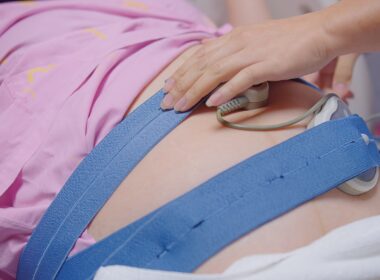This is the second part in our Postpartum Guidebook series.
Author’s Note: neither Natural Womanhood nor I personally have any connection to nor affiliation with any site or resource mentioned in this article. I’ve simply found these to be immensely helpful in my own postpartum experience and am sharing for that reason.
Many of us find ourselves eager to “get our bodies back” after having a baby. But rushing into intense exercise postpartum can have disastrous consequences, from injuries, to hormonal issues, to incontinence and more.
In the first installment of our series on the “fourth trimester,” we covered what you need to know about postpartum nutrition. Now, we’re addressing the physical aspect of the early postpartum period, focusing on your body’s real need for rest and healing after birth–whether you delivered vaginally or via Cesarean section. We also address common questions around postpartum exercise–when can you start? What types of activity are best at first? What are signs and symptoms that you should consult a pelvic floor-trained physical therapist, either before you resume working out postpartum or once you’ve begun?
Your postpartum body needs to heal–and that means rest
While many women feel pressure to “bounce back” quickly after their babies are born (and whether that pressure is internal or external, perceived or actual), in reality, women need a significant period of rest. This is especially true in the first six weeks postpartum. Certainly, resting is more challenging for some. Many women have to return to work just a few weeks after their babies are born for financial or job security reasons, others don’t have help caring for their older children or with household tasks, etc. But every woman’s body needs rest after her baby is born, and some rest is always better than none.
Why is rest so important? For starters, labor and birth are physically demanding activities, whether you deliver vaginally or via Cesarean section. Your body needs time to rest after what many liken to running a marathon. Also, as you may already know, regardless of which route your baby was born, the wound left behind by the placenta’s detachment from your endometrium can be up to the size of a dinner plate! Along with healing that area, you may need to recover from stitches to repair an episiotomy or a natural tear sustained during a vaginal delivery. Moms who underwent a C-section have to recover from a major abdominal surgery. All of these wounds and injuries require time and rest to heal. One way your body tells you to slow down or take things easier is if your lochia increases again (i.e. your bleeding gets heavier) after tapering off following your baby’s birth.
In her book In the Flo, hormone expert Alisa Vitti offers extra motivation to take it easy in the first months postpartum. She observes, “If you don’t listen to your body and try to lose the baby weight by going on some low-calorie diet and heading straight to boot camp, your body will fight back by going into fat storage mode. Pushing yourself too hard also depletes your stores of nutrients, energy, and hormones and can lead to adrenal fatigue and thyroid issues that can linger for years” (Vitti, 148).
Labor and delivery wounds or injuries aside, your muscles, which have stretched to 2-3 times their normal length over the last 9+ months of your pregnancy, along with your ligaments, will certainly need months and even up to a year to heal. Given this, “baby body boot camps” or other intense exercise undertaken in an effort to “get your body back” in the first few months postpartum may actually delay your healing, and run the risk of causing incontinence (leakage of urine or stool) or pelvic organ prolapse.
Physical rest does mean sleeping as much as you can, but it also means sitting down when possible, putting your feet up, and taking breaks in between household tasks. When you do feel the need to get up and move, go for a brief walk. Walks are especially good for moms who are recovering from a C-section in order to reduce the risk of blood clots. You might consider a baby-wearing walk depending on the weather, or you might choose to walk solo to give yourself some alone time. Besides gentle breathing and pelvic floor exercises, walking is the only “exercise” you should be engaging in during the first six weeks, or until you’ve had your postpartum follow-up.
The bottom line? To the extent that you can, given your support system and other factors, rest as much as possible.
How do you know if you need pelvic floor physical therapy?
Every postpartum woman needs to specifically retrain her abdominal muscles and strengthen her pelvic floor. You can get safely started in the first weeks postpartum in the comfort of your living room with these simple exercises.
But when should you seek professional help strengthening your pelvic floor? Lily Nichols, author of Real Food for Pregnancy, shares concerning symptoms for pelvic organ prolapse, which occurs when your uterus, bowel, or bladder bulge down into or even out of the vagina. Signs that warrant a professional workup include “pressure, dragging, or fullness in the pelvic region, sensations of bulging, or the feeling of ‘sitting on a ball’” (Nichols, 244). Painful sex and constipation can also be signs of a dysfunctional pelvic floor–both of which can be helped by pelvic floor therapy.
While any woman experiencing the above symptoms should seek immediate professional help, Nichols actually recommends that all newly postpartum women consult a women’s health physical therapist, also called a pelvic floor therapist, before resuming exercise after being cleared by their doctor, midwife, etc., since a pelvic floor assessment is sadly not a component of the 6 week visit. Pelvic floor physical therapist April Ritz agreed with Nichols, telling Natural Womanhood:
“I highly recommend all postpartum moms attend at least one, if not two or three sessions with a therapist to address a) the core muscles (diaphragm, abdominals, pelvic floor and multifidus) b) scar mobility if a C-section incision or perineal tearing is present c) good posture d) lifting techniques to brace core and pelvic floor, and e) education about safely returning to exercise.”
At a minimum, Ritz says “Women with a third or fourth degree tear should automatically be referred for rehab postpartum” and added “If you are struggling with urinary incontinence after 6 weeks, tailbone pain or pelvic pain, find a therapist near you!” If all of that isn’t enough to convince you to seek out postpartum pelvic floor therapy, consider this: Pelvic floor physical therapy is standard-of-care for all postpartum women in France, which is (as this article puts it) “Why French women don’t pee their pants when they laugh and you do.”
When you’re ready to start working out again postpartum
If you’re interested in following a set postpartum exercise plan, be picky! I like this one because the goal is not weight loss or “getting your pre-baby body back,” but rather gently retraining your abdominal muscles to improve diastasis recti (the abdominal muscle separation that occurs in the majority of pregnant women) and your pelvic floor after nine-ish months of pregnancy and, for many women, the vaginal birth process. A rule of thumb for the first few months postpartum is to emphasize low-impact activities like swimming, pilates, or cycling over high-impact or intense activities like anything involving jumping, kickboxing, running, etc. Ritz coaches her patients that “a return to running shouldn’t be until 3 months postpartum at the earliest, and only if there is no leakage, pelvic heaviness, or pain.”
Additionally, avoid exercises that will exacerbate diastasis recti such as push ups or planks. When I’m personally ready to progressively ramp up the exercise intensity and pursue weight loss, I’ll be looking into this 12 week plan, created by a personal trainer whose prenatal videos I watched while pregnant. More helpful info on C-section specific exercises can be found here.
So far, we’ve explored best practices for optimizing nutrition and physical rest and healing during the postpartum time. In our final installment, we’ll cover another pillar of postpartum wellness: promoting emotional health.
The Fourth Trimester Guidebook: Postpartum Nutrition
Sex after Birth: How to Know if (and When) You’re Ready
Everything You Need to Know about Postpartum Bleeding, aka Lochia







